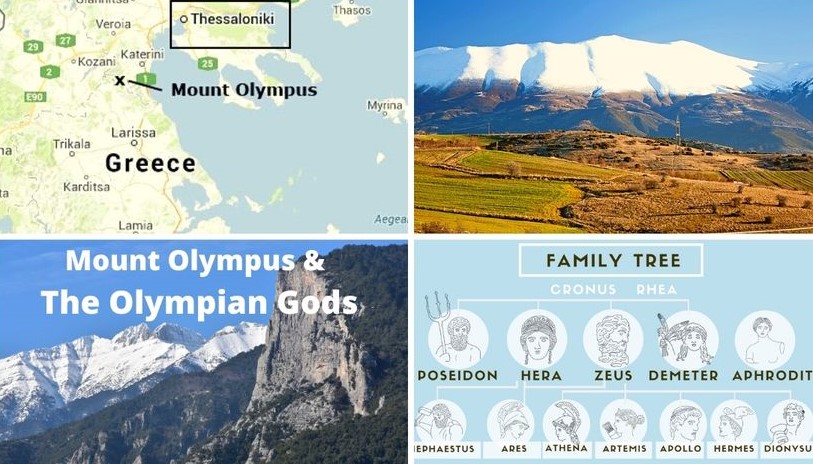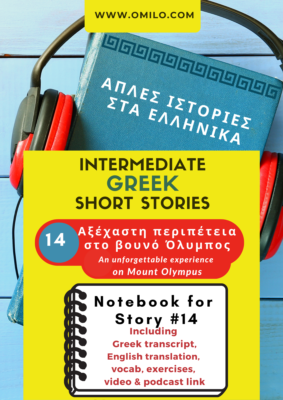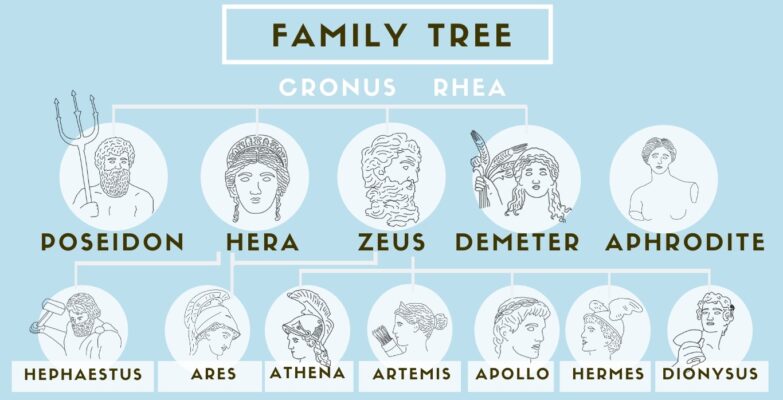Greece, Greek Language
The Mount Olympus, Twelve Olympian Gods and a Podcast
The Greek mythology stories are some of the most famous in the world: from Hercules’ labours to the voyage of Odysseus, Jason’s quest for the golden fleece to the start of the Trojan War, these stories have long outlasted the civilisation that created them. They are still popular nowadays, as well as in Hollywood, were they are often used as an inspiration to create new movies.
There were many more than 12 Gods in ancient Greece or Mythology, but the 12 gods and goddesses dominated myths and worship: the Twelve Olympians, who were living on the Mount Olympus.
The Olympians gained their supremacy in a “war of Gods” in which Zeus led his siblings to victory over the “Titans”.
Hades, the god of the underworld, was viewed as important but is not included in this list as he did not reside on the legendary Mount Olympus.
How many Olympian gods are there?
The ancient Greeks didn’t create a “Top Ten” list of Gods – but they did have the “Top Twelve” – those 12 Gods were living on the highest mountain in Greece, the Olympus.
However, the ancient Greeks did not have a just twelve gods, but there were big and smaller gods and others that were worshiped locally, e.g. Zeus, Poseidon and Hades were the greatest gods,
The gods living on Olympus were twelve -six men and 6 women.; Zeus, Poseidon, Apollo, Hephaestus, Mars, Hermes, Hera, Athena, Aphrodite, Artemis, Demeter, and Estia.
Read more details about the 12 names below.
Mount Olympus
Not only this mountain is known in Mythology, but it is actually a real mountain, loved by many mountaineers and walkers.
Mount Olympus sits on the border of the regions of Thessaly and Macedonia. The easiest access to the mountain and its trails is from the tourist village of Litochoro, at the base of the mountain. It is about 1 hour driving from Thessaloniki, or 5 hours driving from Athens.
Of course, it’s no surprise that magical stories grew up around Mount Olympus. since it rises almost straight from the Aegean Sea to a height of 2917 meters (that’s 9570 feet ), making it the tallest mountain in Greece and the second tallest mountain in the Balkans. Its lower slopes are broken by narrow, densely forested gorges marked by waterfalls and caves where lesser gods and other spirits were said to live.
Its peaks – and there are 52 separate peaks – are snow-capped for 8 months of the year and often hidden in the clouds the rest of the time.
In 1938, 92 square miles covering the mountain and the surrounding area, became the first Greek National Park. This was in recognition of the area’s extraordinary bio-diversity. In 1981 UNESCO classified the region as the Olympus Biosphere Reserve. It is also included in an EU list of the most important bird areas of the European Community and is currently on a tentative list of UNESCO World Heritage sites.
If you are an experienced mountaineer, hiking to the summits of Mount Olympus is not difficult. However, many visitors seem to underestimate the challenges and try to hike the mountain unprepared and without a map. Every year, there are mountain rescues and fatal accidents on the Olympus, so be careful!
Easy Greek Podcast Story 14, For Intermediate Levels.
Curious what can happen on mount Olympus? Then listen to the podcast story #14, of the Omilo Easy Greek Podcast Stories.
Click here to listen to the video with subtitles in Greek.
If you prefer to also have the English translation of the text, with vocabulary list, grammar excercises and background info about Greece,
then click here to find its Companion Notebook of Podcast story 14.
Who are the 12 Olympian Gods?
Zeus (Jupiter)
- King of the gods and ruler of Olympus
- God of the sky and thunder
- Symbols include the thunderbolt, eagle, oak tree, scepter,
Zeus, king of the gods, was the most powerful of all the those in Greek mythology. Son of Cronus and Rhea, he defeated his father Cronus and released his siblings from his belly. He was often called the god of lightning and thunder because he controlled the weather but was also known for being the god of justice. He is often depicted with a lightning bolt or a sceptre.
While he married his sister Hera, he was also known to be a prolific adulterer, bearing children with both other goddesses and mortals. One of the most important statues of Zeus can be seen at the National Archaeological museum in Athens.
Poseidon (Neptune)
- God of the seas, earthquakes and tidal wave
- Symbols include the horse, bull, dolphin, and trident
- Married to the Nereid Amphitrite, but also he had many lovers
- When the basis of the Greek livelihood shifted from the land to the sea, Poseidon has been connected with horses as well as the sea
You can visit the temple of Poseidon in Sounion, Attiki. Click here to read more about this amazing temple,
Apollo (Phoebus)
- God of light, knowledge, healing, plague and darkness, the arts, music, poetry, prophecy, archery, the sun, manly youth, and beauty
- Symbols include the sun, lyre, bow and arrow, raven, dolphin, wolf and swan
- The birth of Apollo; Leto found the barren floating island of Delos, which was neither mainland nor a real island, and gave birth there
Interested to read more about Delos, then click here. - Ares (Mars)
- God of war, violence, and bloodshed
- Symbols include the boar, serpent, dog, vulture, spear, and shield
- Son of Zeus and Hera
Hephaestus (Vulcan)
- The God of fire and the forge
- Master blacksmith and craftsman of the Gods
- Symbols include fire, anvil, axe, donkey, hammer, tongs
- Son of Hera, either by Zeus or alone
The Fall from Olympus; Hephaestus was the only Olympian who returned to Olympus after being exiled
Hermes (Mercury)
- The God of commerce, thieves, and games
- The Messenger of the gods
- Symbols include the caduceus, winged sandals and cap, stork, and tortoise
- Son of Zeus and the nymph Maia
- Homer invokes Hermes as the one “of many shifts (polytropos), blandly cunning, a robber, a cattle driver, a bringer of dreams, a watcher by night etc.
- Hermes is considered as an inventor of fire
Hera (juno)
Queen of the gods and wife and sister of Zeus.
- Goddess of marriage and family
- Symbols include the peacock, pomegranate, crown, cuckoo, lion, and cow
- She tried to get revenge on Zeus’ lovers and their children
Demeter (Ceres)
- Goddess of fertility, agriculture, nature, and the seasons
- Middle daughter of Cronus and Rhea
- Symbols include the poppy, wheat, torch, and pig
Demeter and Persephone
- Demeter’s virgin daughter Persephone was abducted to the underworld by Hades
- Persephone’s time in the underworld corresponds with the unfruitful seasons of the ancient Greek calendar and her return to the upper world with springtime
Athena (Minerva)
- Goddess of wisdom, handicrafts, defense, and strategic warfare
- Daughter of Zeus and the Oceanid Metis
- Symbols include the owl and the olive tree
Artemis (Diana)
- Goddess of the hunt, virginity, childbirth, archery, the moon, and all animals
- Symbols include the moon, deer, hound, she-bear, snake, cypress tree, and bow and arrow
- Daughter of Zeus and Leto and twin sister of Apollo
Aphrodite (Venus)
- Goddess of love, beauty, and desire
- Symbols include the dove, bird, apple, bee, swan and myrtle
- She was born from the sea foam after Uranus’ semen
- Married to Hephaestus
-
Hestia (Vesta)
- Goddess of the hearth and of the right ordering of domesticity and the family
- She is the first child of Cronus and Rhea, eldest sister of Hades, Demeter, Poseidon, Hera and Zeus
- She is the eldest of the Olympians
- Hestia was known for her kindness
- Since the hearth is immovable, Hestia is unable to take part even in the procession of the gods
- Hestia’s nearest Roman equivalent,
- Vesta, had similar functions
Hades, Persephone?
Hades is also an important god and the brother of Zeus and Poseidon, but was not generally considered to be one of the twelve Olympians since he dwelled in the underworld. Similarly, Demeter’s daughter Persephone is also omitted from the list of the Olympians, though she dwells there for one-half or one-third of the year, depending on which mythological interpretation is preferred.
The “Six Olympians” also exist!
While in general today everybody thinks of the “12 Olympians”, there was a smaller core group of just six who were the children of Cronus and Rhea – Hestia, Demeter, Hera, Hades, Poseidon, and Zeus. In that group, Hades is always included.



